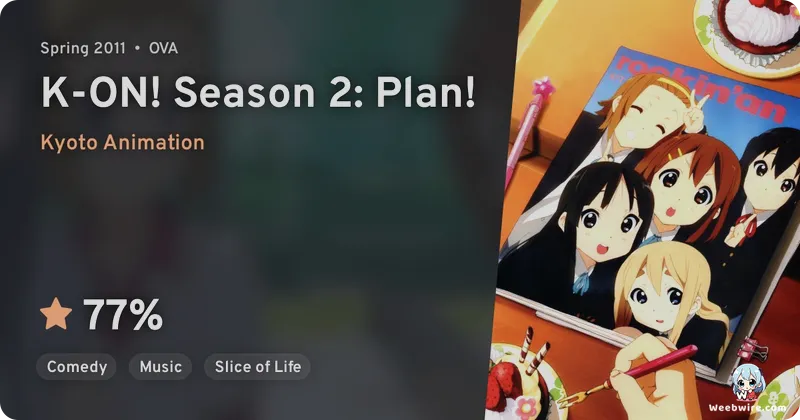K-ON! Season 2: Unpacking the Enduring Legacy, Hidden Homages, and Real-World Impact of a Global Phenomenon

In the vibrant tapestry of modern anime, few series resonate with the cultural depth and unique charm of Kyoto Animation's K-ON!, with its second season holding a particularly cherished spot in fans' hearts. Affectionately dubbed K-ON! Season 2: Plan! by its dedicated community, this moniker, while unofficial, perfectly encapsulates the spirit of the Light Music Club's pivotal final year at Sakuragaoka High School. This period sees every moment, whether spontaneous or meticulously crafted, contribute to the girls' unforgettable journey of youth. Beyond its universally adored narrative and infectious musical numbers, the series is a treasure trove of intriguing details and behind-the-scenes insights that have solidified its legendary status.
Meticulous Craftsmanship and Musical Homages
A hallmark of K-ON! is its meticulous attention to detail, subtly woven into the animation. A prime example is the origin of the main characters' surnames: Hirasawa, Akiyama, Tainaka, and Kotobuki. These are famously inspired by the members of the influential Japanese techno-pop band P-MODEL, a thoughtful musical homage often missed by casual viewers. Even Azusa Nakano's name draws from the Azusa Nakano railway station. This clever naming convention offers a glimpse into the underlying depth of what appears, on the surface, to be a simple slice-of-life premise.
Kyoto Animation, celebrated for its unparalleled animation quality, invested considerable effort into accurately depicting the instruments wielded by the girls. From the intricate fretwork of Yui Hirasawa's beloved Gibson Les Paul, affectionately known as 'Gita', to Mio Akiyama's distinct left-handed Fender Jazz Bass, animators rigorously researched and recreated every nuance of playing. This dedication extended to precise finger placements, strumming techniques, and the subtle movements of the performers. This level of realism is rarely achieved in anime featuring musical acts. This commitment not only enriched the viewing experience for musicians but also ignited the passion of countless aspiring players globally.
Real-World Impact and Authentic Performances
The real-world influence of K-ON! on instrument sales is a well-documented cultural phenomenon. Following the anime's overwhelming success, Japan witnessed a notable surge in demand for electric guitars, bass guitars, and drum kits, particularly among young women. Numerous music stores reported an uptick in customers specifically seeking instruments inspired by the Light Music Club members. This profound ripple effect highlights the anime's power to transcend mere entertainment, genuinely motivating its audience to engage with music.
Further enhancing the series' authenticity and charm was the involvement of its voice cast. The five principal voice actresses, Aki Toyosaki (Yui), Yoko Hikasa (Mio), Satomi Sato (Ritsu), Minako Kotobuki (Mugi), and Ayana Taketatsu (Azusa), formed a real-life band, 'Ho-kago Tea Time' (After School Tea Time), adopting their characters' band name. They performed the anime's opening, ending, and various insert songs live in concert, fostering an unparalleled synergy between the actors and their roles, and blurring the lines between fiction and reality for devoted fans.
A Beloved Setting and Emotional Resonance
Another delightful, yet frequently overlooked, element is the series' setting. Sakuragaoka High School's building draws heavy inspiration from the real-life former Toyosato Elementary School in Shiga Prefecture, Japan. This beautifully preserved historical site has become a pilgrimage destination for fans, proudly displaying various K-ON! memorabilia. This fusion of fictional narrative with tangible real-world locations adds an immersive layer to the K-ON! experience, fostering a deeper connection for viewers to the girls' everyday lives.
Season 2, in particular, masterfully balances its characteristic lighthearted antics and comedic moments with genuinely poignant themes of personal growth, enduring friendship, and the bittersweet nature of farewells. The emotional weight of the graduation arc, culminating in the heartfelt song 'Tenshi ni Fureta yo!' ('Touched by an Angel!'), resonated profoundly with audiences, often eliciting tears from even the most stoic. This remarkable ability to evoke strong emotions while preserving its signature gentle humor stands as a testament to Kyoto Animation's storytelling prowess and Kakifly's original manga.
The Enduring Legacy of Tea, Sweets, and Friendship
The ubiquitous presence of tea and sweets during the Light Music Club's 'practice' sessions transcends a simple running gag; it symbolizes their unique philosophy towards band life. This philosophy prioritizes friendship and collective enjoyment above strict adherence to practice schedules. This distinctive approach became a beloved hallmark of the series, endearing the characters to millions and reinforcing the idea that shared moments of joy are as vital as the pursuit of perfection.
K-ON! did more than just entertain; it cultivated a sense of community among its fans, celebrated life's simple pleasures, and left an indelible mark on the anime industry by popularizing the 'cute girls doing cute things' (CGDCT) subgenre. Its legacy is not merely in its critical acclaim or commercial success, but in the countless smiles it inspired, the instruments it encouraged hands to pick up, and the enduring warmth it continues to radiate. It proves that sometimes, the most profound stories unfold in the most ordinary of days. The 'Plan!' for the Light Music Club was always beautifully simple: cherish every moment together, and in doing so, they composed a timeless melody that continues to echo in the hearts of fans worldwide.
Credits
K-ON!
Author
Kakifly
Cover Art
Kakifly
Studio
Kyoto Animation
Publisher
Houbunsha
Producers





